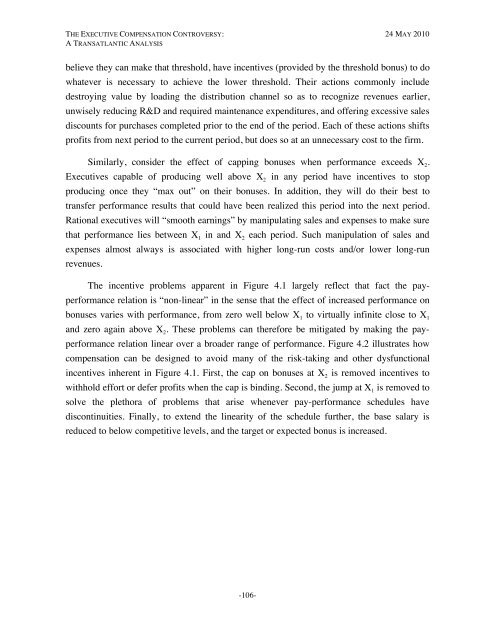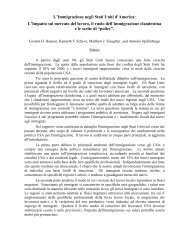The Executive Compensation Controversy - Fondazione Rodolfo ...
The Executive Compensation Controversy - Fondazione Rodolfo ...
The Executive Compensation Controversy - Fondazione Rodolfo ...
You also want an ePaper? Increase the reach of your titles
YUMPU automatically turns print PDFs into web optimized ePapers that Google loves.
THE EXECUTIVE COMPENSATION CONTROVERSY: 24 MAY 2010A TRANSATLANTIC ANALYSISbelieve they can make that threshold, have incentives (provided by the threshold bonus) to dowhatever is necessary to achieve the lower threshold. <strong>The</strong>ir actions commonly includedestroying value by loading the distribution channel so as to recognize revenues earlier,unwisely reducing R&D and required maintenance expenditures, and offering excessive salesdiscounts for purchases completed prior to the end of the period. Each of these actions shiftsprofits from next period to the current period, but does so at an unnecessary cost to the firm.Similarly, consider the effect of capping bonuses when performance exceeds X 2 .<strong>Executive</strong>s capable of producing well above X 2 in any period have incentives to stopproducing once they “max out” on their bonuses. In addition, they will do their best totransfer performance results that could have been realized this period into the next period.Rational executives will “smooth earnings” by manipulating sales and expenses to make surethat performance lies between X 1 in and X 2 each period. Such manipulation of sales andexpenses almost always is associated with higher long-run costs and/or lower long-runrevenues.<strong>The</strong> incentive problems apparent in Figure 4.1 largely reflect that fact the payperformancerelation is “non-linear” in the sense that the effect of increased performance onbonuses varies with performance, from zero well below X 1 to virtually infinite close to X 1and zero again above X 2 . <strong>The</strong>se problems can therefore be mitigated by making the payperformancerelation linear over a broader range of performance. Figure 4.2 illustrates howcompensation can be designed to avoid many of the risk-taking and other dysfunctionalincentives inherent in Figure 4.1. First, the cap on bonuses at X 2 is removed incentives towithhold effort or defer profits when the cap is binding. Second, the jump at X 1 is removed tosolve the plethora of problems that arise whenever pay-performance schedules havediscontinuities. Finally, to extend the linearity of the schedule further, the base salary isreduced to below competitive levels, and the target or expected bonus is increased.-106-









